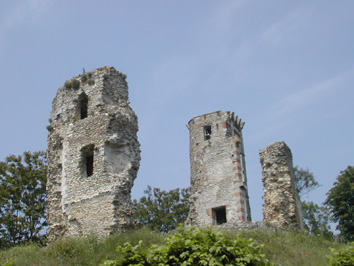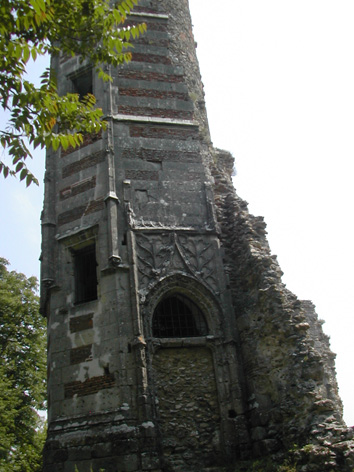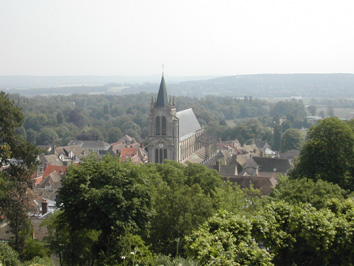History
Par Maria Kuzmina, Thursday 21 June 2007 à 12:42 :: Montfort-l'Amaury - millennium of history :: #3 :: rss

Photo M.K.
Montfort is one of those well-kept medieval towns that seems too good to be true. Its narrow streets of picturesque houses are built on the slopes of a citadel crowned by the ruined walls of a castle and encircled by the remnants of medieval ramparts. A stately church dominates the town centre, its clock chiming the quarters, and the shops cater for residents with leisure and taste.
Many of them are Parisians who own second homes in and around Montfort. Perhaps the best-known resident was the composer Maurice Ravel, whose house has been turned into an eerie museum, preserved exactly as it was when he died in 1937. A later resident, the film director Henri Georges Clouzot, made Montfort the setting for two of this films, and until quite recently the Auberge de la Moutière restaurant was a favourite venue for fashionable Parisians.
But there is more to Montfort than its picture-postcard charm and its artistic residents.
It is a story of violence, constant adaptation and triumphant continuity; and it begins with the Roman road from Beauvais to Chartres, which crosses the town from north to south before entering the Forest of Rambouillet. The hill overlooking this strategic route was fortified in 996 on the orders of Robert the Pious, son of the Hugues Capet, the first king of France. The village became a fortress (Mont Fort) with a castle surrounded y ramparts, its defence entrusted to the descendants of the builder, who became Counts of Montfort.
Amaury, the first of these, gave the town its name, and founded a dynasty which included Simon IV de Montfort (1165-1218), notorious for his brutal leadership of the Albigensian Crusade against the Cathars in the South of France. His defeat of the heretics enabled Louis VIII to add the Earldom of Toulouse to the expanding kingdom of France. His son, Simon V de Montfort (1192-1265) married the sister of Henry III of England and is credited with the founding, of the first English parliament in opposition to his brother-in-law. The 700th anniversary of this event was celebrated in Montfort with grate pomp in 1965. in fact, the history of the rulers of Montfort is so entangled with the fortunes of the Capetien kings of France and the Plantagenets of England that it is difficult to separate them. What does emerge is the fragility of the French kingdom, constantly threatened by unruly vassals and with invasions by the English, themselves descendants of a powerful neighbour, William of Normandy. As the Plantagenets were linked by marriage to the Montfort family, both the king of England and the king of France laid claim to Montfort in the 14th century and a lengthy war ensued, during which the castle and most of the ramparts were razed by the English. Two fragments of the castle walls are all that remain. Through an earlier connection by marriage with the rulers of Brittany, Montfort eventually passed to Anne de Bretagne (1477-1514), whose subsequent marriages to two French kings definitively established the town as part of the kingdom of France.

Photo M.K.
The ruined tower on the hilltop was part of the Renaissance château built by Anne de Bretagne, who also began the enlargement of the 11th-century church. A second set of ramparts was built in the 16th century at the instigation of Charles IX, who promised the town a charter of independence in return. It became an important administrative centre for the region, which included the Forest of Montfort (it became Rambouillet under Napoleon I) and the little village of Versailles.
However, the expansion of Versailles under Louis XIV led to a decline in the importance of Montfort, which passed to the Duc de Luynes. During the Revolution the 11th-century chapel on the hill was requisitioned from the magistrate to whom it had been sold off, for use as a prison for the Chouans – participants in the counter-revolutionary uprising led by Jean Chouan in the Vendée from 1793 to 1800. they died there of starvation in conditions so atrocious that the owner had it demolished after the fall of Robespiere in 1794, so that such scenes could never be repeated in Montfort. Under Napoleon the administration of the district was transferred to Rambouillet and Montfort suffered the further indignity of occupation after the French defeat at Waterloo in 1815. the occupation was presumably by the Prussians – the local history in understandably vague on this point.

Photo M.K.
In the 19th century the 16th-century ramparts were demolished, in the mistaken belief that the population would continue to expand. Montfort’s popularity with artists and writers dates from this period, Victor Hugo’s Romantic poem to its ruined castle setting the fashion, which has continued to the present day.
From Annabel Simms "An Hour From Paris"
Official site www.anhourfromparis.com
Commentaires
Aucun commentaire pour le moment.
Ajouter un commentaire
Les commentaires pour ce billet sont fermés.